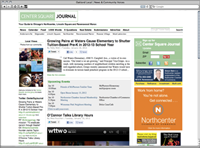Today, Fourcher oversees two other online news sites in addition to Center Square: the Roscoe View Journal and Edgeville Buzz. The three sites make up a local news network called Brown Line Media, and offer community-based news coverage throughout a stretch of densely populated residential and mixed-use neighborhoods on Chicago’s North Side.
In Edgewater and Andersonville (the two main coverage areas for the Edgeville site), crime, ward politics, and local business growth top the list of resident interests. “Trying to get businesses to develop there is a big chore, and they’re really straining to grow the community,” says Fourcher. Articles in the Center Square and Roscoe sites, which cover areas with a slightly more affluent population, shift more toward the matters of real estate development and the progress of public schools in the urban neighborhoods of Roscoe Village, Ravenswood Manor, and Northcenter.
Fourcher founded the Roscoe View site a few months after Center Square, recognizing an opportunity for reporting in the area just south of his original beat. The new neighborhood was free from any local competition, and Fourcher was able to assign to Roscoe View stories to his growing ring of writers from the Center Square pages. “I thought it was a different set of neighborhoods, and I wanted to see if I could build a second business,” he says. In summer 2011, Edgeville Buzz, then in its third year of publication, was added to the network after Fourcher formed a partnership with founders Lyle Bright and Jeremy Bressman. “I liked their writing,” he says. “They were even-handed; they really strove to be involved in the community.”
Aside from Fourcher’s contributions, content in Center Square and Roscoe View is generated by about eight regular freelance writers, with the majority of the Edgeville copy produced by Bright and Bressman. Though he does welcome input from “volunteer community correspondents,” Fourcher says that he prefers reporters with chops over aspiring citizen journalists. “We don’t really have bloggers, we have people who are quality writers,” he says. BLM pays reporters based on word count, but also takes into account the amount of work and time invested in individual pieces. For example, Center Square recently published a story on a murder case, and the experienced court reporter who researched and wrote the story was paid more than the average rate for her efforts.
Brown Line Media’s coverage area reaches out over a patch of Chicago that was once the territory of Lerner Newspapers, a now extinct weekly chain that put out individual papers in suburban neighborhoods and pocket communities in the city from the mid-1920s to 2005. The company–which published fifty-four papers in all, including early iterations of News-Star and Booster–began shedding editions in the 1980s, giving over its often-loyal readership to Chicago’s two major dailies.
The “one neighborhood, one paper” model still has merit to Fourcher, though the game has changed, he says. It used to be that “if you could put together a distribution network where you got your paper on someone’s front porch every day or once week, you were doing pretty good. That’s not the case anymore,” he says. “People aren’t going to go to us just because they don’t have any other choice, they’re going to read us because they really like the site, and that’s a lot of work.” The three sites see a combined total of between 150,000 and 175,000 visitors per month, Fourcher says.
Brown Line Media collects revenues from around fifty ad clients a year for spaces that run between $50 per month for a sidebar and $500 for header banners. Fourcher says the sites are now self-sustaining, with one full-time advertising rep and another salesperson paid on commission. The three sites share ad clients–a model that Fourcher has expanded upon as manager of the Chicago Independent Ad Network, a marketing venture that sells blocks of pooled ad space from an alliance of independent media sites in Chicago. Though he declines to discuss specific revenue numners, Fourcher says that he does pay himself a salary for managing the sites. He spends about 60 percent of his time working on business growth and the other 40 percent on editorial duties.
In addition to original reporting, the Brown Line Media outlets provide calendar listings, a Flickr photo section, and daily roundups of neighborhood-specific clippings from the city’s menagerie of media outlets.
Fourcher says that the strength of his local news resides in keeping “community news” focused on the neighborhood and the people and businesses that reside within it.
“We never write a city hall story,” he says. “Not interested.”
 CHICAGO, ILLINOIS — Though he writes a vast majority of the posts on his flagship news site, Center Square Journal, Mike Fourcher prefers the title of publisher over journalist. “That’s an important distinction,” he says. “I do employ journalists… but the person that runs a baseball bat company is not a carpenter.”
CHICAGO, ILLINOIS — Though he writes a vast majority of the posts on his flagship news site, Center Square Journal, Mike Fourcher prefers the title of publisher over journalist. “That’s an important distinction,” he says. “I do employ journalists… but the person that runs a baseball bat company is not a carpenter.”
